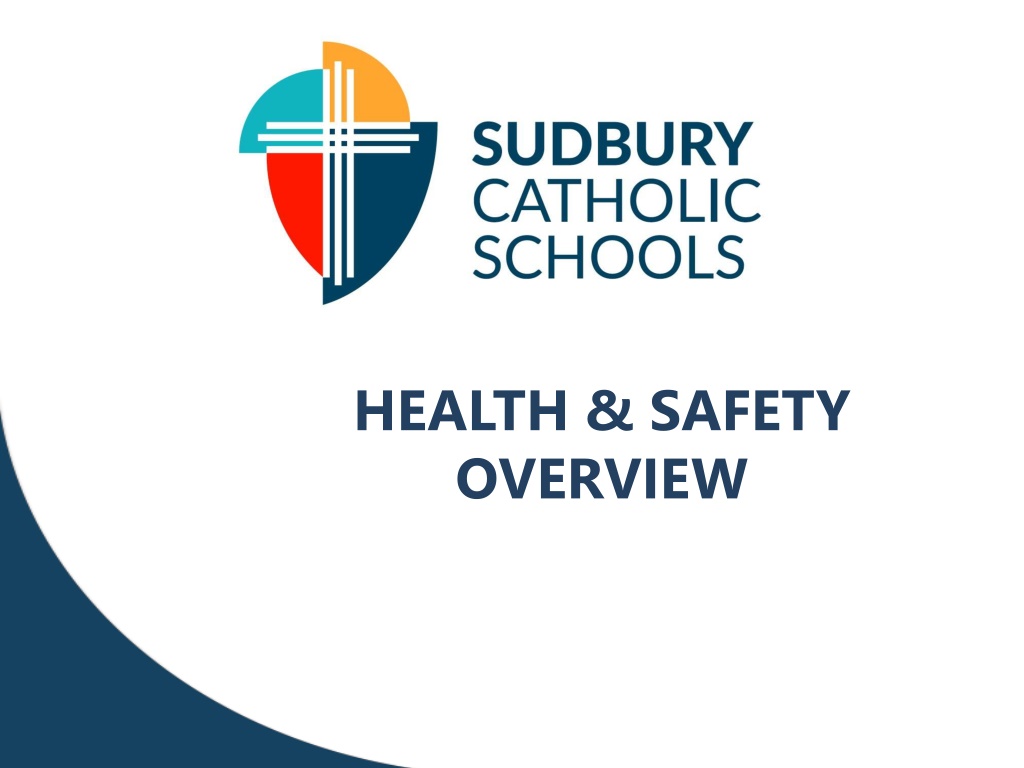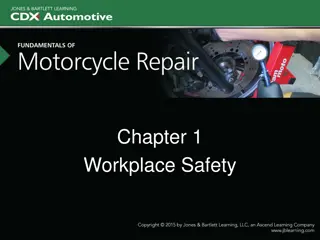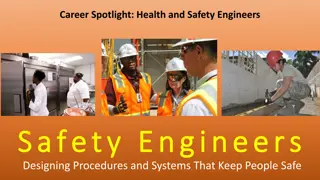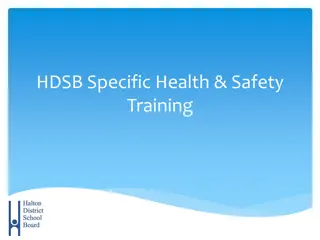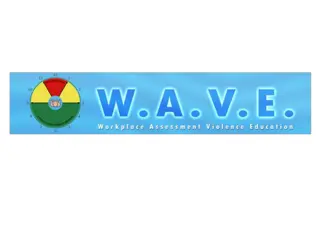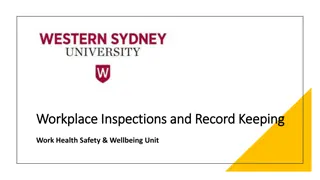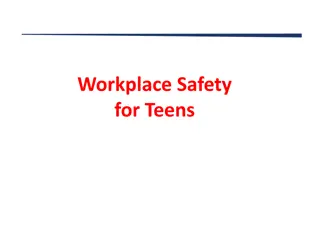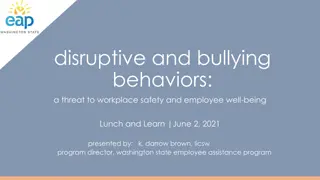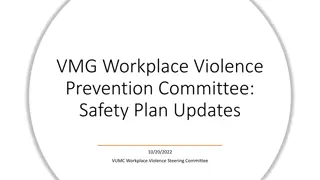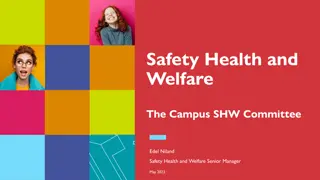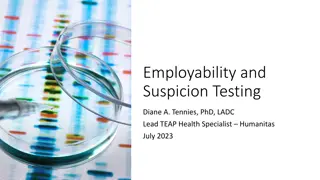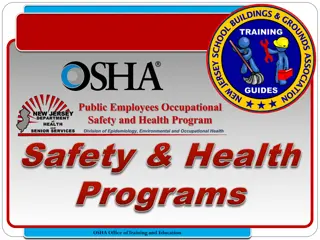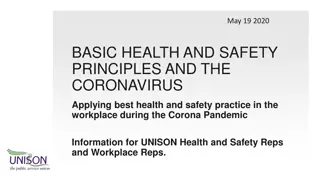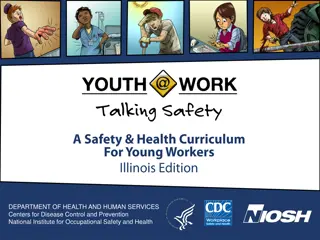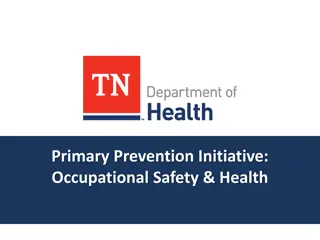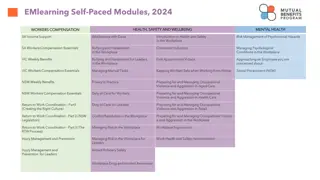Importance of Health and Safety in the Workplace
Health and safety are crucial for all employees, as outlined in the Ontario Health and Safety Act. Employers and employees share the responsibility of creating a safe work environment through enforcement, compliance, and partnership. Understanding hazards, both safety and health-related, is key in preventing workplace injuries and diseases. Employees have the right to know about various hazards such as slips, trips, falls, fire risks, chemical exposure, and workplace violence. By being aware of these risks, individuals can take necessary precautions to ensure their well-being and that of their colleagues.
Download Presentation

Please find below an Image/Link to download the presentation.
The content on the website is provided AS IS for your information and personal use only. It may not be sold, licensed, or shared on other websites without obtaining consent from the author. Download presentation by click this link. If you encounter any issues during the download, it is possible that the publisher has removed the file from their server.
E N D
Presentation Transcript
HEALTH & SAFETY OVERVIEW
Health & Safety Important for All Employees Ontario Health and Safety Act (OH&SA): Ontario's cornerstone legislation for workplace health and safety. The goal of our Health & Safety program is to prevent occupational injury and disease health & safety is everyone s responsibility.
Health & Safety Everyone has a Responsibility Employers and employees work in partnership to promote and improve health and safety within the Board. Three pillars for internal processes: 1) Enforcement 2) Compliance 3) Partnership
What is a Hazard? An occupational hazard is a thing or situation with the potential to harm a worker. Occupational hazards can be divided into two categories: - safety hazards that cause accidents that physically injure workers, and - health hazards which result in the development of disease. A "hazard" only represents a potential to cause harm. Whether it actually does cause harm will depend on circumstances, such as the toxicity of the health hazard, exposure amount, and duration. Hazards can also be rated according to the severity of the harm they cause.
1.Employee Right to Know Hazards, as identified in Major Risk Assessment Hazards, as identified in Major Risk Assessment Slips/trips/falls (e.g. risk of sprain, strain, or fracture) contributing factors: Working with ladders and scaffolds Overextending or using object other than a ladder to reach something Liquids/spills on the floor Improper footwear Inattention Exposure to body fluids (e.g. risk of HIV, virus, Hepatitis C) Ergonomic: includes inadequate lighting; unsuitable workstation set-up; improper lifting technique; repetitious movements over and over (e.g. risk of strain, sprain, bursitis, etc.)
1. Employee Right to Know, continued Hazards, as identified in our Major Risk Assessment Hazards, as identified in our Major Risk Assessment Fire (e.g. risk of burn, asphyxiation) Asbestos Exposure ( e.g. risk of asbestosis) Chemical Exposure (e.g. risk of burns, irritated eyes, etc.) Controlled Energy Source (e.g. risk of electrical shock) Constant loud noise (e.g. risk of hearing loss) Exposure to sunlight/uv rays, heat or cold (e.g. risk of sunburn, heat stroke, frostbite) Unsecured objects such as filing cabinets (risk of injury from a fallen object) Violence in the Workplace
Examples of Controls for Hazards Participating in safety related training Personal Protective Equipment e.g. gloves, respirators, masks Lock Out/Tag Out Procedure use of tags and locks for unsafe equipment Wear sun screen, hat, keep hydrated with water Wear appropriate footwear for the activity Ability to summon emergency assistance Appropriate workstation layout, appropriate breaks
2. The Right to Refuse Employees have the right to refuse work that they believe is unsafe and unhealthy. Speak with your supervisor, who will investigate to determine whether danger exists. Locate our Work Refusal Reporting Form on Intranet, under Health & Safety forms
OH&SA and the Education Act OH&SA Section 2(2): Despite anything in any general or special Act, the provisions of this Act and the regulations prevail. This means that the Occupational Health & Safety Act supersedes all other Acts respecting safety of workers, including the Education Act; however, we must comply with both Acts to ensure the safety of our students. Part V of the OHSA Act (right to refuse) does not apply to a teacher where the circumstances are such that the life, health or safety of a pupil is in imminent jeopardy.
Incident Reporting Our online reporting process links the Ministry of Education, The Ministry of Labour and the Workplace Safety and Insurance Board reporting requirements. Type of reporting includes: 1. Occupational Accident / Illness 2. Violence and Harassment 3. Safe Schools 4. Health Concern Report / Near Miss Report through the online incident reporting system called EBASE. The web address is located on the Intranet under Forms and Documents and then Health and Safety. This link can then be saved for future use. https://sudburycatholicschools.ebasefm.com/ There are training guides that are located on the intranet and when logged into EBASE there is a Help section with videos to assist with form completion. You can also request assistance from your supervisor.
Reporting Occupational Accidents and Illnesses Staff, students on placement, and volunteers must report any accident/injury that occurs during their assignment with the Board. Report to your supervisor if you: Seek medical attention from a health care practitioner and/or Incur an absence from work (or assignment) - referred to as a lost time injury For Students on Placement Students on Placement, an absence from work includes an absence from work on a part-time job outside of placement hours. Students on Placement must also complete a WSIB Form 6. Make sure to ask your supervisor how to report any accident and injury.
Reporting under Safe Schools Safe Schools is a term from the Ministry of Education. Ongoing efforts, province wide, to make Ontario s schools safe and accepting for students and staff requires all School Board employees (not just teachers) to report to their principal any incident that can lead to suspension or expulsion of a student. Staff use EBASE in order to report incidents, as required under Safe Schools. Ask the principal for guidance on what to report.
3.The Right to Participate Employees participate in the Joint Health equal number of worker representatives and employer representatives on JHSC. Employees can also serve as an Alternate Representative Alternate Representative and assist with monthly workplace inspections, which are a proactive means of preventing accidents. As noted in the APG HS03 Workplace safety inspections APG HS03 Workplace safety inspections are a means of preventing accidents. All employees are responsible for: Conducting pre-use inspections of equipment, materials, and operating procedures Reporting to their supervisor/designate any unsafe acts or conditions observed during the course of their duties Providing information during a regulated inspection regarding any health & Safety Concerns in the workplace. Formal Workplace inspections are conducted by the worker representative on the Joint Health and Safety Committee or Alternate Member, as well as by a management representative. Joint Health and and Safety Committee Safety Committee (JHSC). There is an
Duties and Responsibilities Employee Work in compliance of the Act and Regulations. Use or wear any equipment or safety devices as provided by the employer, and follow all safety procedures as directed by your supervisor or the training provided. Report to your supervisor all safety concerns, including safety defects in equipment, missing protective devices or hazards. Report to your supervisor any known violation of the Act and Regulations, including by co-workers.
Duties and Responsibilities Continued Do not remove or make ineffective any required protective devices as required for performing the duties of your job. Do not use unsafe equipment or work in such a way that would endanger yourself or others. Keep all materials {especially combustible} off the heating vents, do not hang things from ceiling, do not pile boxes to the point where they become unmanageable and dangerous to move, or where they may topple over, etc. Report/record incidents of violence and harassment.
Examples of Safe Practices Spot the Hazard Employees should use a proper step ladder and never stand on a table, desk, or chair. Employees must ensure they have proper safe electrical equipment (all plugs have grounds, extension cords are CSA approved and not frayed).
Universal Precautions Five Steps of Universal Precautions: Education Hand Washing Wearing Protective Barriers Cleaning Contaminated Surfaces Disposal of Contaminated Articles
Scent Awareness Please note that we have staff members at who have Scent Allergies. Their access to our buildings is significantly restricted if there are scented products within the environment. These products can trigger serious health conditions. These scented products can include perfume, cologne, lotion, aftershave, scented deodorant, hair spray and/or any fragrances.
Workplace Hazardous Materials Information Systems (WHMIS) All hazardous materials used in our workplace must be properly labeled. For employees using hazardous materials Safety Data Sheet (SDS Sheets) are located on the Board s website under the For Staff tab, staff intranet. Please select CCOHS SDS site . Please d Please do not bring chemical products (e.g, cleaning products) from home to school
Footwear Safety Wear appropriate footwear for your working conditions. Refer to APG#HS09 Footwear Safety for more details. Utilize your professional judgement professional judgement and choose appropriate footwear to meet the needs related to your duties. Check Check with your supervisor when unsure and request a recommendation. (e.g. field trips). Be Be aware aware of surroundings and conditions that may dictate the use of appropriate footwear. Ensure that footwear is in good condition good condition. Report Report potentially hazardous conditions that could contribute to a slip/trip or fall to your supervisor.
First Aid First Aid training First Aid training At least one school secretary per school, all principals, all vice-principals, and all Assistant Custodians, Custodians, and Building Service Technicians (BSTs) are trained in First Aid First Aid Kits First Aid Kits There are staff kits and student kits See the person with first aid training in the school/work location for location/access to the staff first aid kit
Emergency Procedures All schools will have emergency binders. Please see your principal and/or supervisor for further instructions/directions and for the location of worksite specific information. Ensure you are aware Ensure you are aware of the following: - Location of emergency exits - emergency procedures - necessary steps to take in an emergency situation of the following:
Fire Safety Locate fire alarms and extinguishers at your work location Actively participate in any fire drill; ask questions Upon Discovery of Fire: Call 9-1-1 if you are using a School board phone please dial 9-9-1-1 Sound fire alarm Close doors once you re sure the room has been evacuated Leave fire area immediately Leave building via nearest exit Do not use elevator
Emergency Contact Numbers Life Threatening Emergency Situation 9-1-1 Poison Information 1-800-268-9017 Telehealth Ontario 1-866-797-0000
